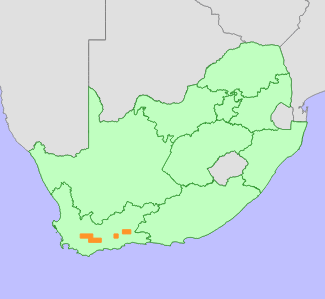|
Scientific Name | Leucadendron cordatum E.Phillips |
Higher Classification | Dicotyledons |
Family | PROTEACEAE |
Synonyms | Leucadendron humifusum E.Phillips & Hutch. |
Common Names | Droopy Conebush (e) |
National Status |
Status and Criteria | Rare |
Assessment Date | 2019/08/09 |
Assessor(s) | A.G. Rebelo, H. Mtshali & L. von Staden |
Justification | A rare species occurring in low densities in isolated areas in the Swartberg and Langeberg. It has a restricted distribution range, with an extent of occurrence (EOO) of 8160 km², and an area of occupancy (AOO) of 184 km². It is potentially threatened by too frequent fire, but the population is not currently declining, and therefore it is not in danger of extinction. |
Distribution |
Endemism | South African endemic |
Provincial distribution | Western Cape |
Range | This species occurs in two geographically isolated areas in the Little Karoo - the Langeberg above the Koo Valley to Barrydale, and Swartberg Mountains above Klaarstroom. There is a historical record from the Rooiberg near Calitzdorp, but the subpopulation could not be relocated during Protea Atlas Project surveys. |
Habitat and Ecology |
Major system | Terrestrial |
Major habitats | North Swartberg Sandstone Fynbos, North Langeberg Sandstone Fynbos |
Description | It occurs on rocky sandstone slopes in dry mountain fynbos, 700-1700 m. Mature individuals are killed by fires, and only seeds survive. Seeds are released after ripening, and collected by rodents and stored in underground caches, where they are protected from fires. It is dioecious, with insect-pollinated male and female flowers occurring on separate plants. |
Threats |
| There was some decline on the lower slopes of the Swartberg due to habitat loss to crop cultivation in the past, but this threat has ceased, as upper slopes are generally unsuited to cultivation and most are in protected areas. Only about 2% of this species' habitat is currently irreversibly modified. As a reseeder, Leucadendron cordatum is potentially vulnerable to increases in fire frequency. Recent field observations noted too frequent fires occurring in the Swartberg. |
Population |
This species occurs in small, scattered clumps, and especially in the Swartberg, population density is low (3-4 plants per hectare). Seeds are dispersed over very short distances, and therefore subpopulations are prone to isolation, making them vulnerable to local extinction due to stochastic events, and limiting recolonization through dispersal, as has been observed in the Rooiberg, an isolated mountain between the Swartberg and Langeberg. The species has a persistent soil-stored seedbank, from which it can potentially regenerate under suitable conditions, but the longevity of soil-stored seeds is not known.
There was some population decline due to habitat loss in the past, on lower slopes where sandstone derived soils grade into richer shale derived soils, but subpopulations on upper slopes are unlikely to be impacted by this threat. There is no suspected current continuing population decline, and although many subpopulations are small and isolated, not more than 50% of the population is in small and isolated subpopulations.
|
Population trend | Stable |
Notes |
| Leucadendron cordatum occurs as two distinct forms, that are geographically isolated. Plants in the Langeberg are prostrate, creeping along the ground, while those in the Swartberg are erect with pendent flowers. These probably warrant recognition as separate species. |
Assessment History |
Taxon assessed |
Status and Criteria |
Citation/Red List version | | Leucadendron cordatum E.Phillips | Rare | Raimondo et al. (2009) | | Leucadendron cordatum E.Phillips | Not Threatened | Hilton-Taylor (1996) | |
Bibliography |
Goldblatt, P. and Manning, J.C. 2000. Cape Plants: A conspectus of the Cape Flora of South Africa. Strelitzia 9. National Botanical Institute, Cape Town.
Hilton-Taylor, C. 1996. Red data list of southern African plants. Strelitzia 4. South African National Botanical Institute, Pretoria.
Raimondo, D., von Staden, L., Foden, W., Victor, J.E., Helme, N.A., Turner, R.C., Kamundi, D.A. and Manyama, P.A. 2009. Red List of South African Plants. Strelitzia 25. South African National Biodiversity Institute, Pretoria.
Rebelo, T. 2001. Sasol Proteas: A field guide to the proteas of southern Africa. (2nd ed.). Fernwood Press, Vlaeberg, Cape Town.
|
Citation |
| Rebelo, A.G., Mtshali, H. & von Staden, L. 2019. Leucadendron cordatum E.Phillips. National Assessment: Red List of South African Plants version . Accessed on 2025/08/20 |
 Comment on this assessment
Comment on this assessment

